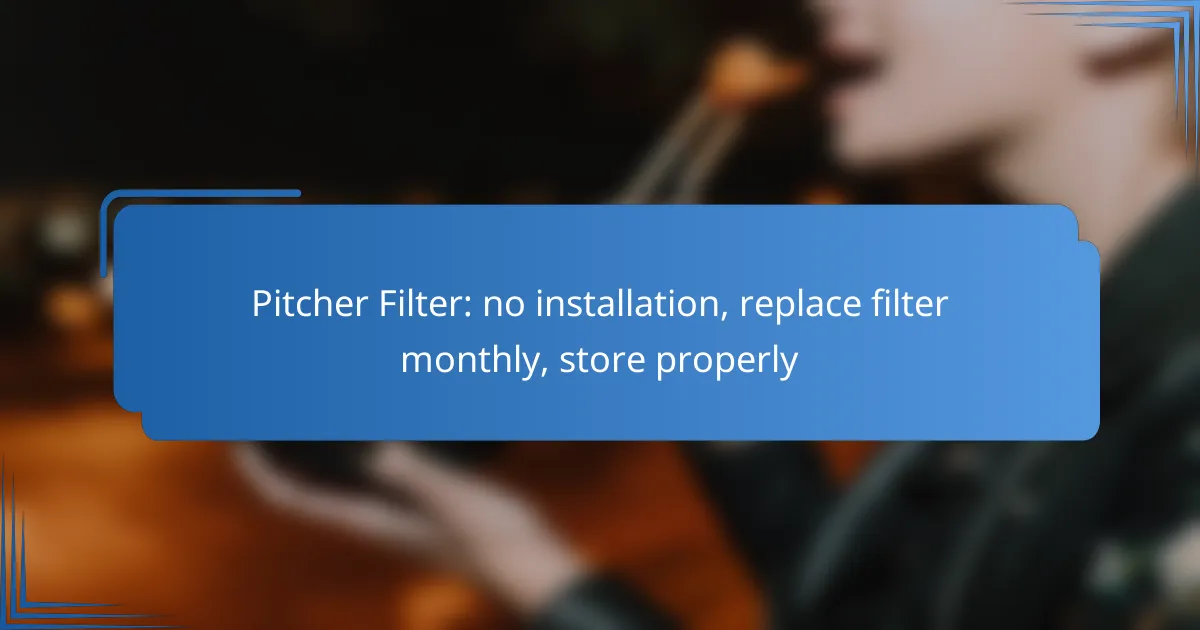Pitcher filters offer a hassle-free solution for improving tap water quality without any installation required. Simply fill the pitcher, and as the water passes through the filter, impurities like chlorine and sediment are effectively reduced. To maintain optimal performance and taste, remember to replace the filter monthly and store the pitcher properly.

How do pitcher filters work without installation?
Pitcher filters operate by utilizing a simple filtration system that removes impurities from tap water without requiring any installation. Users fill the pitcher with water, and as it passes through the filter, contaminants such as chlorine, sediment, and some heavy metals are reduced, resulting in cleaner drinking water.
Simple design for easy use
The design of pitcher filters is straightforward, making them user-friendly. Typically, they consist of a reservoir for water and a filter cartridge that sits in the lid or inside the pitcher. Users simply fill the top reservoir, and gravity pulls the water through the filter into the bottom compartment.
Most pitcher filters are lightweight and portable, allowing for easy storage in a refrigerator or on a countertop. This convenience means that anyone can use them without needing technical skills or tools.
No plumbing required
One of the main advantages of pitcher filters is that they require no plumbing or installation, making them accessible for everyone. Users can start filtering water immediately after purchasing the pitcher, eliminating the need for professional installation or modifications to existing plumbing systems.
This feature is particularly beneficial for renters or those living in temporary housing, where making permanent changes is not feasible. Additionally, it allows for easy relocation; users can simply take the pitcher with them wherever they go.

What are the benefits of using pitcher filters?
Pitcher filters provide a convenient way to improve the quality of drinking water without the need for installation. By replacing the filter monthly and storing the pitcher properly, users can enjoy better-tasting water while reducing harmful contaminants.
Improved water taste
Using pitcher filters significantly enhances the taste of tap water, making it more palatable. These filters typically reduce chlorine and other unpleasant flavors, resulting in a fresher and cleaner taste.
For optimal results, it’s essential to replace the filter monthly, as this ensures the filter remains effective in removing taste-altering substances. Storing the pitcher in a cool, dark place can also help maintain water quality.
Reduced contaminants
Pitcher filters are designed to reduce various contaminants found in tap water, including lead, mercury, and certain bacteria. This reduction helps improve overall water safety, making it a practical choice for households.
While pitcher filters cannot eliminate all contaminants, they can significantly lower levels of many harmful substances. Regularly replacing the filter is crucial for maintaining its effectiveness in reducing these contaminants.

How often should I replace my pitcher filter?
You should replace your pitcher filter monthly to ensure optimal water quality and taste. Regular replacement helps remove contaminants effectively and maintains the filter’s performance.
Monthly replacement recommended
Replacing your pitcher filter every month is a simple practice that guarantees clean drinking water. This timeframe is based on average usage, which typically involves filtering a few liters of water daily.
To make this easier, consider marking a calendar or setting a reminder on your phone. This way, you won’t forget to replace the filter, ensuring your water remains fresh and safe.
Manufacturer guidelines
Most manufacturers recommend a monthly replacement schedule for their pitcher filters, but it’s essential to check the specific guidelines for your brand. Some filters may have different lifespans based on the model and the contaminants they target.
Always refer to the user manual or the manufacturer’s website for precise instructions. Following these guidelines will help you avoid potential issues with water quality and ensure your filter operates effectively.

What are the best pitcher filters available?
The best pitcher filters are designed for easy use, requiring no installation and monthly replacement. They effectively reduce contaminants in tap water, making it safer and more palatable for daily consumption.
Brita Everyday Pitcher
The Brita Everyday Pitcher is a popular choice for its affordability and effectiveness. It features a simple filter replacement system that should be done approximately every month to maintain optimal performance.
This pitcher reduces chlorine taste and odor, as well as other common contaminants. It holds about 10 cups of water, making it suitable for small to medium households.
To ensure longevity, store the pitcher in a cool place and avoid direct sunlight, which can degrade the filter faster.
ZeroWater Pitcher
The ZeroWater Pitcher offers a more advanced filtration system that includes a five-stage filter, which can remove nearly all dissolved solids from water. Like the Brita, it requires monthly filter replacements for continued effectiveness.
This pitcher is ideal for those who want the purest water possible, as it can significantly lower total dissolved solids (TDS) levels. It typically holds about 8 cups of water, making it suitable for individuals or small families.
Store the ZeroWater pitcher properly by keeping it in a cool, shaded area to extend the life of the filter and maintain water quality.

How should I store my pitcher filter properly?
To store your pitcher filter properly, keep it in a location that maintains its effectiveness and longevity. Proper storage prevents contamination and ensures that the filter performs optimally for its intended lifespan.
Keep in a cool, dry place
Storing your pitcher filter in a cool, dry place is essential to prevent mold and bacteria growth. Ideal storage temperatures are typically between 10°C and 25°C (50°F to 77°F). Avoid areas like kitchens or bathrooms where humidity levels can fluctuate significantly.
Consider using a sealed container to further protect the filter from moisture and contaminants. This simple step can extend the filter’s usability and maintain water quality.
Avoid direct sunlight
Direct sunlight can degrade the materials of your pitcher filter, reducing its effectiveness. Store the filter away from windows or bright light sources to prevent UV damage. A dark cupboard or pantry is often a suitable choice.
Additionally, prolonged exposure to sunlight can lead to temperature increases, which may negatively affect the filter’s performance. Always check the storage conditions if you notice any changes in water taste or clarity.

What factors should I consider when choosing a pitcher filter?
When selecting a pitcher filter, consider its filter lifespan, contaminant reduction capabilities, and ease of use. These factors will help ensure you choose a filter that meets your needs while providing safe drinking water.
Filter lifespan
The filter lifespan is crucial as it dictates how often you need to replace the filter, typically on a monthly basis. Look for filters that clearly state their lifespan in terms of gallons or months, as this will help you plan for replacements and avoid running out of filtration capacity.
Many pitcher filters can last anywhere from 40 to 100 gallons, depending on the brand and model. Regularly check the filter indicator, if available, to ensure optimal performance and water quality.
Contaminant reduction capabilities
Different pitcher filters target various contaminants, so it’s essential to choose one that meets your specific water quality needs. Common contaminants include chlorine, lead, and sediment, and filters may vary in their effectiveness against these substances.
Review the product specifications and look for certifications, such as NSF/ANSI standards, which indicate the filter’s ability to reduce specific contaminants. This will help you make an informed decision based on your local water quality reports and personal health concerns.

How do pitcher filters compare to faucet filters?
Pitcher filters and faucet filters serve the same purpose of improving water quality, but they differ in installation, maintenance, and convenience. Pitcher filters are portable and require no installation, while faucet filters are attached directly to the tap and may offer more extensive filtration options.
Cost-effectiveness
Pitcher filters are generally more affordable upfront compared to faucet filters, making them a popular choice for budget-conscious consumers. The cost of replacement filters for pitchers typically ranges from $5 to $15 per month, depending on the brand and filter type.
Faucet filters, while initially more expensive, may provide a longer-term solution with lower ongoing costs. They often have a higher capacity and can filter more water before needing a replacement, which can be more economical over time.
Ease of use
Using a pitcher filter is straightforward: fill the pitcher, wait for the water to filter, and pour. This simplicity makes it ideal for households that prefer minimal setup and maintenance.
Faucet filters, while easy to install, require a bit more effort to switch between filtered and unfiltered water. Users must remember to change the filter regularly, which can be a drawback for some. Proper storage of pitcher filters when not in use is essential to maintain their effectiveness, while faucet filters are always ready for use when attached to the tap.

What are common issues with pitcher filters?
Common issues with pitcher filters include clogging and inconsistent water taste. These problems can affect the filter’s performance and the quality of the water you consume.
Clogging problems
Clogging is a frequent issue with pitcher filters, often caused by the accumulation of sediment and contaminants. When the filter becomes clogged, water flow slows down, making it less efficient and requiring more frequent replacements.
To minimize clogging, regularly replace the filter as recommended, typically every month. Additionally, ensure that the pitcher is stored properly, avoiding exposure to extreme temperatures that could affect the filter’s integrity.
Inconsistent water taste
Inconsistent water taste can arise from several factors, including the age of the filter and the quality of the source water. Over time, filters may lose their effectiveness, leading to variations in taste that can be unpleasant.
To maintain a consistent flavor, adhere to the monthly filter replacement schedule. If you notice significant changes in taste, check the filter’s expiration date and consider using a different brand that may better suit your water quality needs.
